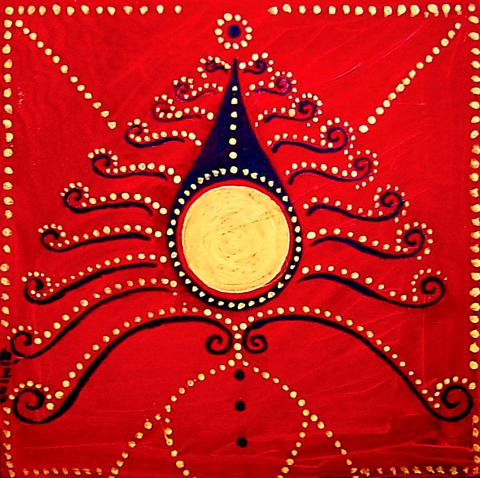The Red Room group has collected a very varied assortment of painters, musicians and other artists from around Taiwan for a day-long event today at Taipei’s Huashan 1914 Creative Park called Artists Beat the Flood 2.
Artists Beat the Flood 2 was launched to help in the building and creation of a shared artistic/creative community in Taiwan. And like the first event, held on Sept. 5, 2009, artists will be painting on site during the day and there will be a silent auction of their works as well as some others that have been donated.
The money raised from the entrance fees and art sale will be used toward event expenses and future events organized by the Red Room, artists, musicians and collaborating parties, participating artist Rohma Mehta told the Taipei Times in an e-mail.

Photo Courtesy of Roma Mehta
Among those who are donating their time and/or works are Taipei-based illustrator Ann Chang, freelance animation director and illustrator JJ Chen, Daniel Desjardins; Charles Haines, poet/painter/jewelry maker Kate Huang (黃莞淑), Constance Woods and self-described “street artist” Joe Fang (方建翔).
The expatriate artists, most of whom are professionals, hail from several countries, including the UK, Croatia, India and Canada.
The event offers visitors a chance to interact with the graphic artists and painters during the creative process and watch how individual works develop.

Photo Courtesy of Aleksandra Tolnauer
However, while the artists will be getting to work early on, starting at 10am, the musical portion of the day does not start until 1pm.
As of press time, the line-up was Almost Irish at 1pm, Josh Drye at 2pm, Future Lands String Quartet at 3pm and the quartet Strawberry Jam Sandwich at 4:30pm. There will be two “unplugged” performances, first by pop rockers Dress Shop at 5:45pm and then Calico (花貓畫國畫) at 7:15pm.
Although the publicity information says the event runs from 10am to 7pm, Calico is not taking the stage until after 7pm, so figure on the show going on at least until 8pm.
COMMUNITY OF ART LOVERS
The Red Room began as Stage Time and Wine@Red Room in November 2009, pulled together by three members of the Mehta family, who were long-term Taipei-based expatriates, architect Leiven Hwang (黃立文), entrepreneur and activist Ping Chu (朱平) and several others, who wanted to create a space where people could share their love of the spoken word, creativity and artistry — as well as some wine and snacks.
While the initial monthly get-togethers focused on sharing poetry and short-story recitations — and some musical contributions — mostly in English, the sessions have evolved and grown more cross-cultural, multi-dimensional and multi-generational, drawing people not just from Taipei, but from around the nation.
Held on the third Saturday of every month, the Red Room is a well-established gathering that regularly packs the second-floor workshop space to capacity. The sign-up book by the door for those who want to share fills up rapidly. It is hard to predict what will be on tap: poetry, a personal memoir, rapping, an interpretive dance, a song on the guzheng (古箏) or liuqin (柳琴).
The creativity unleashed by the Red Room and the camaraderie and networking that are natural by-products have led to some spin-off ventures, including Red Room Radio Redux, which focuses on reader’s theater and radio drama and has done four hour-long drama productions in cooperation with International Community Radio Taipei, and Aside@the Red Room, a curated show. There have also been fundraisers to raise money for Playing for Change, a charity that builds music schools in impoverished areas of Africa and Nepal.

Most heroes are remembered for the battles they fought. Taiwan’s Black Bat Squadron is remembered for flying into Chinese airspace 838 times between 1953 and 1967, and for the 148 men whose sacrifice bought the intelligence that kept Taiwan secure. Two-thirds of the squadron died carrying out missions most people wouldn’t learn about for another 40 years. The squadron lost 15 aircraft and 148 crew members over those 14 years, making it the deadliest unit in Taiwan’s military history by casualty rate. They flew at night, often at low altitudes, straight into some of the most heavily defended airspace in Asia.

Beijing’s ironic, abusive tantrums aimed at Japan since Japanese Prime Minister Sanae Takaichi publicly stated that a Taiwan contingency would be an existential crisis for Japan, have revealed for all the world to see that the People’s Republic of China (PRC) lusts after Okinawa. We all owe Takaichi a debt of thanks for getting the PRC to make that public. The PRC and its netizens, taking their cue from the Chinese Communist Party (CCP), are presenting Okinawa by mirroring the claims about Taiwan. Official PRC propaganda organs began to wax lyrical about Okinawa’s “unsettled status” beginning last month. A Global

Taiwan’s democracy is at risk. Be very alarmed. This is not a drill. The current constitutional crisis progressed slowly, then suddenly. Political tensions, partisan hostility and emotions are all running high right when cool heads and calm negotiation are most needed. Oxford defines brinkmanship as: “The art or practice of pursuing a dangerous policy to the limits of safety before stopping, especially in politics.” It says the term comes from a quote from a 1956 Cold War interview with then-American Secretary of State John Foster Dulles, when he said: ‘The ability to get to the verge without getting into the war is

Like much in the world today, theater has experienced major disruptions over the six years since COVID-19. The pandemic, the war in Ukraine and social media have created a new normal of geopolitical and information uncertainty, and the performing arts are not immune to these effects. “Ten years ago people wanted to come to the theater to engage with important issues, but now the Internet allows them to engage with those issues powerfully and immediately,” said Faith Tan, programming director of the Esplanade in Singapore, speaking last week in Japan. “One reaction to unpredictability has been a renewed emphasis on